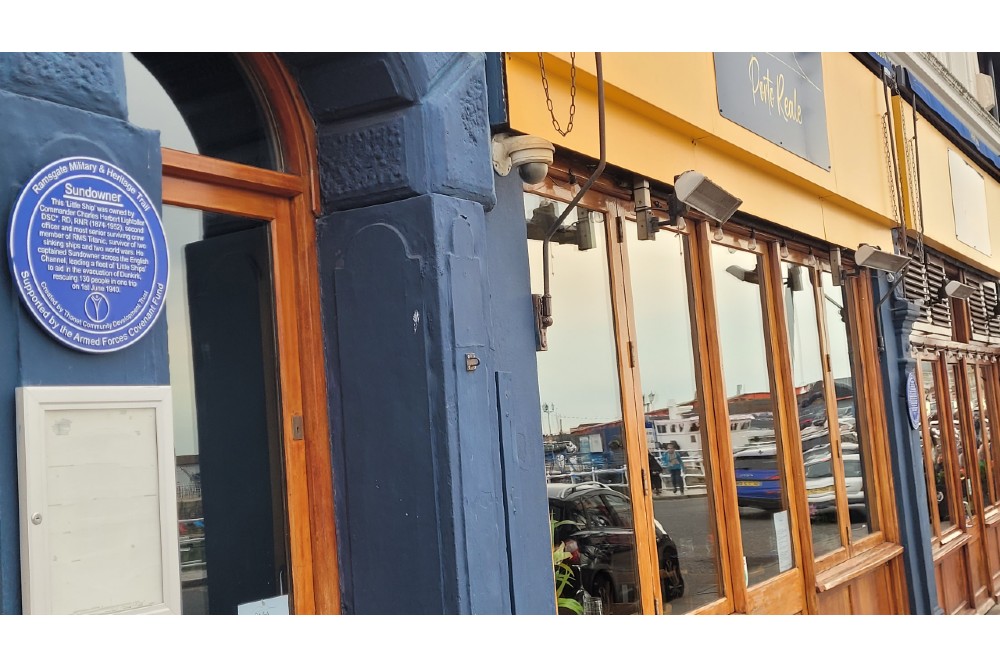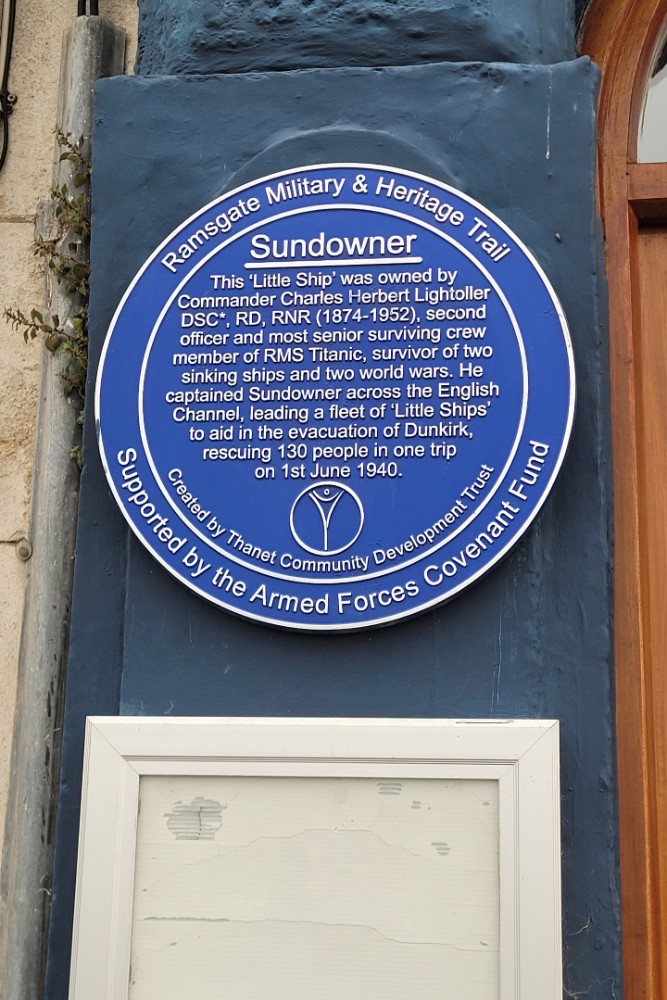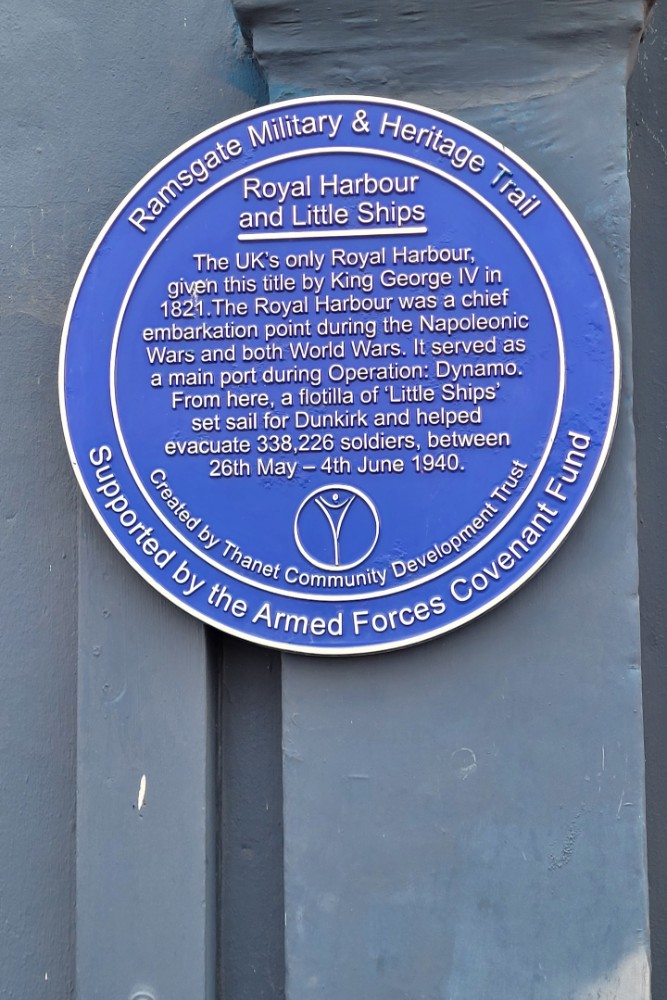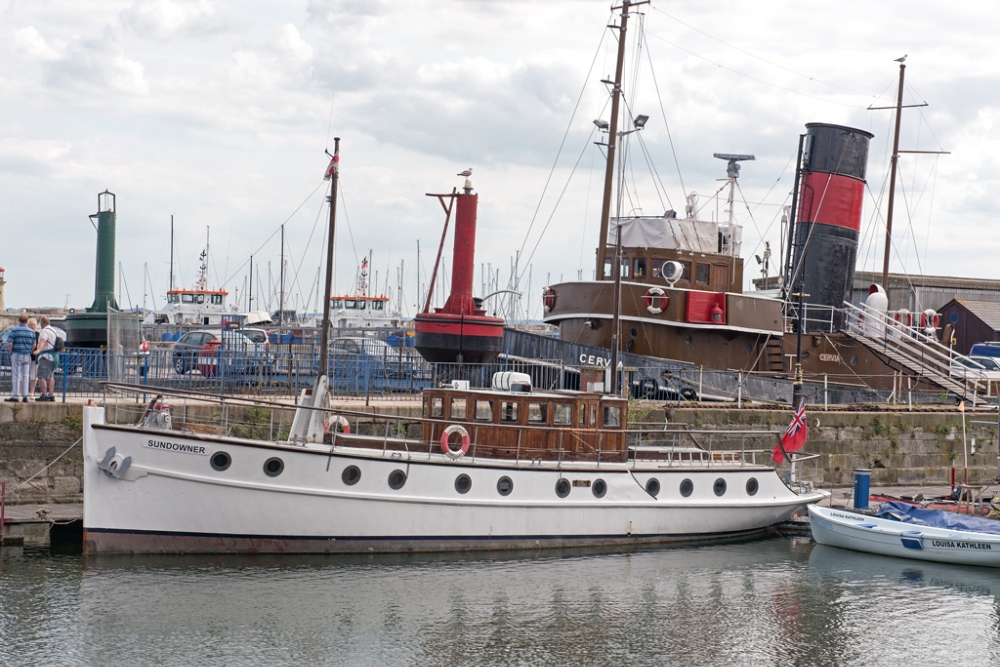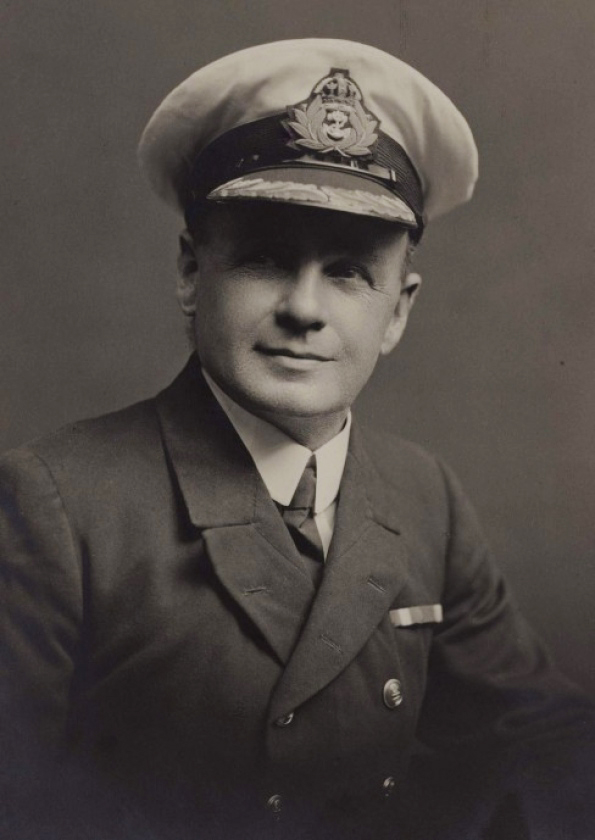Memorials 'Little Ships'
"Sundowner
This 'Little Ship' was owned by Commander Charles Herbert Lightoller DSC & Bar, Rd, RNR (1874-1952), second officer and most senior surviving crew member of RMS Titanic, survivor of two sinking ships and two World Wars. He captained Sundowner across the English Channel, leading a fleet of 'Little Ships' to aid in the evacuation of Dunkirk, rescuing 130 people in one trip on 1st June 1940."
"Royal Harbour and Little Ships
The UK's only Royal Harbour, given this title by King George IV in 1821. The Royal Harbour was a chief embarkation during the Napoleonic Wars and both World Wars. It served as a main port during Operation Dynamo. From here a flotilla of 'Little Ships' set sail for Dunkirk and helped evacuate 338,226 soldiers between 26th May -4th June 1940."
This Admiralty steam launch was disposed of by the Navy at a Sheerness dockyard sale in the late 1920s and converted in 1930 into a private motor yacht by the veteran barge builder Charles Cooper at Richardson's Wharf, Conyer near Sittingbourne in Kent. The work was carried out on the instructions of her new owner, Commander Charles Herbert Lightoller - senior surviving officer of the TITANIC.
Originally 52ft (15.8m) long, SUNDOWNER was later extended to 58 ft (17.7m), converted to a ketch rig and equipped with a centrally placed 60hp Parsons petrol/paraffin 4 stroke engine, giving her a top speed of 8 knots from her single screw. The hull had cost her owner £40, the engine £100 and its reverse gear £35. Lightoller's wife Sylvia named the transformed vessel SUNDOWNER - an Australian term for wanderer. During the 1930s, SUNDOWNER was used for family trips both in home waters and on the continent, and was a regular and successful participant in the 'Pavilion d'Or' competitive trails held at various European venues during this period. In 1936 Lightoller changed the engine for a more powerful (72hp) Gleniffer diesel, giving her an extra 2 knots and, in the summer of the following year, embarked with the family on a cruise of the Baltic, covering 3,000 miles without mechanical difficulties. In 1939, with war threatening, Lightoller was asked by the Admiralty to conduct a secret survey of the German Coast. He agreed and for two weeks, with Sylvia acting as cover, he took SUNDOWNER on a systematic exploration of the Frisian coast and islands.
A year later, on 1 June 1940, with his son Roger and an eighteen year old sea-scout, Gerald Ashcroft, Lightoller - now aged 66 - set out from Ramsgate to assist in the evacuation of Dunkirk. On the way they encountered the motor cruiser WESTERLEY on fire. Having picked up her two crew and three naval ratings on board they carried on towards the Dunkirk beaches. Packed below, lying down for stability, and squeezed on deck with all boots and equipment thrown overboard, was a grand total of 130 persons, including those from the WESTERLEY and SUNDOWNER's own crew, headed back to Ramsgate where they arrived twelve hours after departing that morning. In 1965, a plaque commemorating the event was placed on board SUNDOWNER by the Mayor of Dunkirk.
Lightoller died in 1952 and the family sold SUNDOWNER in 1964. After passing through several hands she finally returned to Ramsgate Harbour in 1986, the victim of a storm off the North Foreland which damaged her steering and planking. In the Autumn of that year the East Kent Maritime Trust began negotiating with her owner for purchase of the vessel. They began a process of fund-raising and restoration which finally resulted in returning SUNDOWNER to her former state. About 40% of the hull's outer planking; more than 20 oak beams and three bulkheads had to be renewed; the keel strengthened and transom repaired. Her wheelhouse, blown off during the hurricane of 1987, had to be completely rebuilt. Her engine, overhauled at H M Dockyard, Rosyth was installed just in time for SUNDOWNER to join the flotilla of surviving 'Little Ships' on their 50th anniversary return to Dunkirk in May 1990, a voyage she repeated in 1995.
Sold by the Trust in charge of Ramsgate Maritime Museum in July 2020, SUNDOWNER is now in private ownership once more. A full restoration is being carried out at Dennett's Boat Yard, starting November 2024.
This vessel is a survivor from the First World War. You can read more about her wartime history by visiting our First World War: Britain's Surviving Vessels website www.ww1britainssurvivingvessels.org.uk.
CHARLES HERBERT LIGHTOLLER was born in Chorley in 1874. At the age of 14 he became apprenticed to a sailing barque in Liverpool. In 1889 he was shipwrecked, and he subsequently endured numerous storms in the Indian Ocean. He obtained his Mates Certificate and switched from sail to steamers, on the West African coast. After nearly drowning and contracting malaria he left the sea for a while, unsuccessfully attempting gold prospecting in America.
He returned to Liverpool in early 1900 and joined the White Star Liner MEDIC as fourth officer. He stayed with White Star and subsequently was made Second Officer on TITANIC, which sank on its maiden voyage in April 1912. After diving from the stricken vessel he reached a raft and was eventually save by CARPATHIA. He was the senior surviving officer.
During the First World War he first commanded a merchantman, and then a Royal Navy Torpedo Boat in the Thames Estuary. He was given a new command with the Dover Patrol hunting German U-boats. One of these he rammed and sank. He was awarded the DSC.
In the 1930s he attempted journalism. In World war Two he served in the Royal Naval Reserve. He had 3 sons and 2 daughters. 2 of the sons died in action. After the war, he set up and ran a boat yard at Twickenham with his surviving son. He died in 1952.
Do you have more information about this location? Inform us!
Source
- Text: Sharky Ward/Memorial
- Photos: Anthony (Sharky) Ward (1, 2, 3), The Carlisle Kid (4), See page for author, Public domain, via Wikimedia Commons (5)
- https://ww1britainssurvivingvessels.org.uk/
- nationalhistoricships.org.uk/register/96/sundowner
Related books
Nearby
Museum
- Ramsgate Tunnels - Ramsgate
- Spitfire and Hurricane Memorial Museum - Ramsgate
- RAF Manston History Museum - Ramsgate
Point of interest
- Memorial 27 Air Sea Rescue Unit - Ramsgate
- Wellington Crescent, Ramsgate - Ramsgate
- Motor Fishing Vessel 617/Starbuck - Ramsgate
Monument
- Memorial Operation Dynamo - Ramsgate
- War Memorial Ramsgate - Ramsgate
- Channel Dash Memorial - Ramsgate
Cemetery
- Commonwealth War Grave St. Augustine Roman Catholic Churchyard - Ramsgate
- Commonwealth War Graves WW1 Plot Ramsgate and St Lawrence Cemetery - Ramsgate
- Commonwealth War Graves Ramsgate and St Lawrence - Ramsgate
